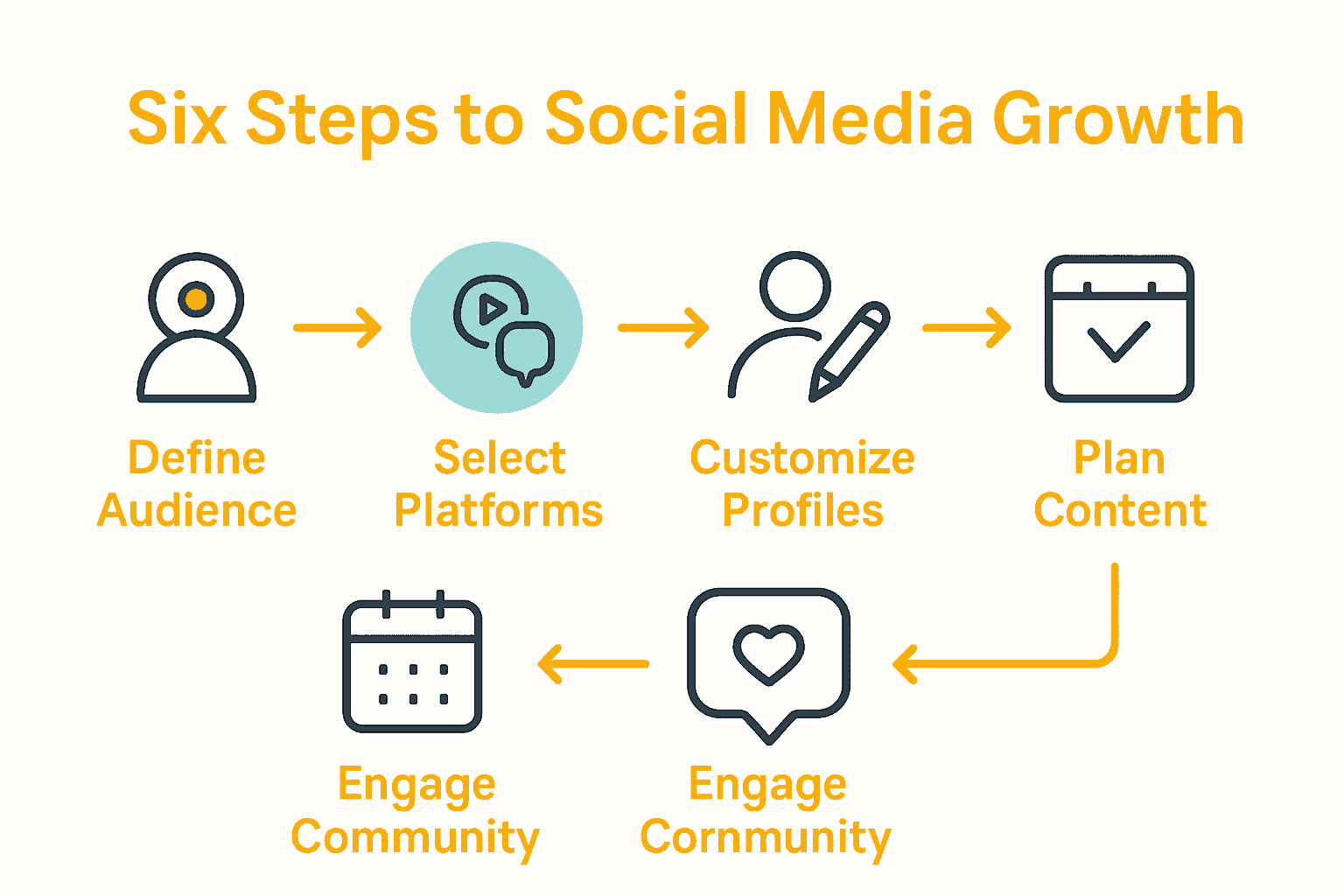How to Market Your Company on Social Media for Growth
- Eddie The Chef

- Nov 13
- 8 min read

Nearly 60 percent of small businesses struggle to turn social media activity into real business results. With so many platforms and constant trends, finding an approach that actually connects with your audience can seem confusing. Understanding who you want to reach and what you want to achieve is the foundation for any successful social strategy. This guide shows how to build a step-by-step plan that attracts the right people and supports your business goals.
Table of Contents
Quick Summary
Key Point | Explanation |
1. Define your target audience | Understand your ideal customer’s demographics to tailor effective marketing campaigns. |
2. Select appropriate social platforms | Choose platforms aligning with audience demographics and content type for optimal reach. |
3. Customize social media profiles | Consistently brand your profiles to attract and engage your target audience effectively. |
4. Plan engaging content regularly | Use scheduling tools to maintain a consistent and relevant posting rhythm for audience engagement. |
5. Measure and refine your strategy | Regularly analyze metrics to adapt your approach, ensuring continuous improvement in performance. |
Step 1: Define your target audience and social media goals
Building an effective social media strategy starts with understanding exactly who you want to reach and what you aim to achieve. This critical first step will help you create targeted marketing efforts that actually generate meaningful results for your business.
According to Perth.wa.gov.au, defining your target audience requires deep insights into specific demographic characteristics. You will need to map out precise details about your ideal customer including their age range, geographic location, income level, professional background, personal interests, and key pain points they experience. By creating a comprehensive profile, you can craft social media content that speaks directly to their needs and motivations.
When establishing your social media goals, focus on outcomes that drive real business growth. As Business.sa.gov.au recommends, your objectives might include increasing brand awareness, generating more website traffic, boosting customer engagement, or directly improving sales performance. The most effective goals are specific measurable and aligned with your broader business strategy.
One practical tip is to create a simple spreadsheet documenting your audience persona and corresponding goals. Break down each characteristic and objective with clear metrics you can track. This will help you stay focused and make data driven decisions as you develop your social media approach.
With your target audience defined and goals established, you are now ready to select the most appropriate social media platforms for reaching your specific market segment.
Step 2: Select the right social platforms for your business
Choosing the most effective social media platforms is critical for reaching your target audience and achieving your business marketing objectives. This step requires strategic thinking and careful analysis of where your potential customers are most active and engaged.
According to Business.gov.au, selecting the right social platforms involves understanding the specific demographics of each platform and how they align with your target audience. You will need to consider factors such as age range, gender, professional interests, and online behavior. Some platforms attract younger professionals while others might have more diverse or mature user bases.
Vic.gov.au recommends evaluating the type of content you plan to share as another key consideration in platform selection. Different social networks excel at different content formats visual platforms like Instagram work brilliantly for image heavy content while LinkedIn suits professional text and article sharing. YouTube is ideal for video content and Twitter works well for short form updates and industry news.
A practical approach is to create a simple comparison matrix listing each social platform potential audience reach content suitability and your specific business goals. This will help you make an informed decision about where to focus your social media marketing efforts.
Once you have selected your primary social media platforms you will be ready to develop a content strategy that resonates with your target audience and supports your business objectives.
Step 3: Create and customise your social media profiles
Customizing your social media profiles is a critical step in establishing a professional online presence that accurately represents your business brand and attracts your target audience. This process involves more than just creating accounts it requires strategic planning and thoughtful execution.
According to SmallBusiness.wa.gov.au, an effective strategy is to research similar businesses in your industry and observe how successful companies set up their social media profiles. Look closely at businesses with strong followings and high engagement rates to understand visual design elements profile descriptions and content approaches that resonate with your potential customers.
GlenEira.vic.gov.au emphasizes the importance of maintaining consistent branding across all social media platforms. This means using the same profile picture logo color schemes and messaging tone to create a unified brand identity. Ensure your profile information is complete including a compelling business description high quality images that represent your brand and clear contact details.
A practical tip is to create a brand style guide that outlines your visual and communication standards. This will help maintain consistency across different social media platforms and make your profiles look professional and cohesive.
With your social media profiles professionally set up and customized you are now prepared to develop a content strategy that will engage your target audience and support your business marketing objectives.

Step 4: Plan and schedule engaging content tailored to your audience
Planning and scheduling social media content is a strategic process that requires careful consideration of your target audience interests and business objectives. Your goal is to create a consistent content stream that keeps your followers engaged and attracts potential customers.
According to Environment.vic.gov.au, utilizing scheduling tools like Meta Business Suite can help you maintain a consistent posting rhythm. These platforms allow you to plan content in advance ensuring you have a steady stream of relevant posts that align with your audience preferences and business goals.
DigitalTransformation.org.au recommends starting with one social media platform and mastering your content strategy before expanding. This approach allows you to develop a deep understanding of what content resonates with your specific audience and refine your approach based on engagement metrics and feedback.
A practical tip is to create a content calendar that outlines your posting schedule including types of content themes and key messaging. This will help you maintain consistency and ensure your social media strategy remains aligned with your overall marketing objectives.
With a well planned and scheduled content strategy you are now ready to start creating and sharing content that will help grow your online presence and connect with your target audience.
Step 5: Engage with your community and monitor interactions
Engaging with your social media community is more than just posting content it is about building meaningful connections and creating a responsive online presence that reflects your brand personality. This crucial step transforms your social media from a broadcast channel to an interactive platform where customers feel heard and valued.
According to Business.qld.gov.au, monitoring interactions allows businesses to respond promptly to feedback and manage their online reputation effectively. This means checking comments responding to messages and acknowledging both positive and constructive feedback in a timely professional manner.
Retail.org.au emphasizes moving beyond purely promotional content and focusing on building genuine relationships. This involves creating posts that invite conversation asking questions sharing behind the scenes glimpses and showing the human side of your business.
A practical strategy is to set aside dedicated time each day for social media interaction. This might involve 15 to 30 minutes of focused engagement where you respond to comments ask follow up questions and show your audience that real people are listening and caring about their input.
By consistently engaging with your community you will not only build trust and loyalty but also gain valuable insights that can help you refine your marketing strategy and better understand your customers needs.
Step 6: Measure results and refine your social media strategy
Measuring and analyzing your social media performance is crucial for understanding what works and continuously improving your marketing approach. This final step transforms raw data into actionable insights that can drive your business growth.
According to Business.gov.au, using tools and analytics to measure return on investment is essential for staying competitive. You will want to track key performance indicators such as engagement rates follower growth reach website traffic and conversion rates. Most social media platforms offer built in analytics tools that provide comprehensive insights into your content performance.
ASBFEO highlights the importance of regular evaluation to identify areas for improvement. This means reviewing your metrics monthly or quarterly and being willing to adapt your strategy based on what the data reveals. Look for patterns in your most successful posts understand what type of content resonates with your audience and be prepared to pivot your approach.
A practical tip is to create a monthly performance dashboard that tracks your key metrics. This will help you visualize your progress and make data driven decisions about your social media strategy.
By consistently measuring and refining your approach you will develop a more effective social media presence that grows with your business and connects meaningfully with your target audience.

Unlock Your Social Media Potential for Real Business Growth
Feeling overwhelmed by the challenge of turning social media into a true growth engine for your regional business? This article clearly identifies common hurdles like selecting the right platforms, creating tailored content, and measuring results meaningfully — all key to building authentic connections with your audience. If you are striving to translate strategies like content scheduling, profile customisation, and community engagement into tangible success, you need a partner who understands the unique dynamics of local markets.
Marketing Recipes Australia brings over 30 years of trusted expertise in digital marketing crafted specifically for regional businesses just like yours. Using a holistic “kitchen-inspired” approach, we combine proven techniques such as video marketing, social media management and creative content creation to help you conquer those exact pain points and transform your social channels into growth drivers.

Take charge of your social media marketing now with a tailored strategy that meets your business goals head-on. Visit Marketing Recipes Australia to discover how our hands-on support and strategic consulting can elevate your brand presence across platforms, engage your community meaningfully, and deliver results where they really count. Don’t wait — start turning your social media efforts into a steady pipeline of loyal customers today by exploring our comprehensive digital marketing solutions at https://marketingrecipes.com.au.
Frequently Asked Questions
How can I define my target audience for social media marketing?
To define your target audience, research key demographic characteristics such as age, location, income, and interests. Create a detailed audience persona that helps tailor your content directly to their needs and preferences.
What social media goals should I set to ensure growth?
Set specific, measurable goals like increasing website traffic or improving customer engagement. For example, aim to boost your engagement rate by 15% over the next three months to align your efforts with measurable business outcomes.
How do I choose the right social media platforms for my business?
Evaluate the demographics and engagement style of different social media platforms to find where your target audience is most active. For example, if your audience is predominantly professionals, consider focusing on LinkedIn to maximize your reach.
What should be included in my social media profiles?
Your social media profiles should feature consistent branding elements like logos, color schemes, and a clear business description. Make sure to include high-quality images and accurate contact information to create a professional and cohesive appearance.
How can I plan and schedule engaging content for social media?
Start by creating a content calendar that outlines your posting schedule, including content types and themes for each post. Aim to plan a month’s worth of content in advance to maintain consistency and relevance with your audience.
How can I measure the effectiveness of my social media strategy?
Use key performance indicators (KPIs) such as engagement rates, follower growth, and website traffic to measure your strategy’s effectiveness. Review these metrics monthly to identify trends and adjust your approach; for instance, focus on content types that drive the highest engagement.
Recommended
Comments